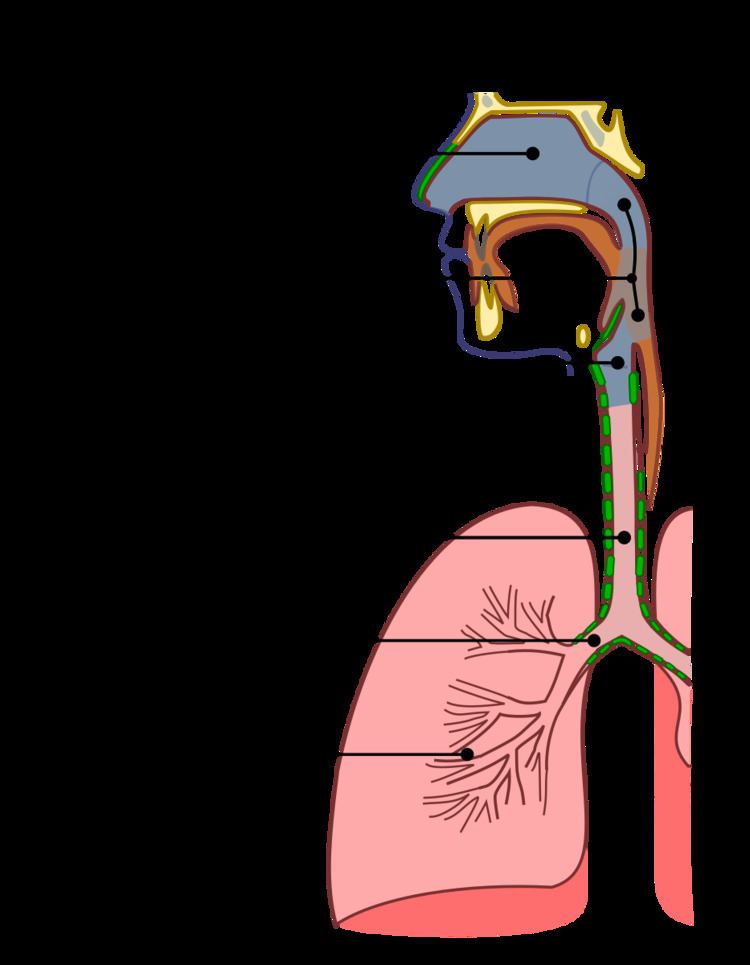Specialty pulmonology | ICD-10 J10-J22, J40-J47 | |
 | ||
'Lower respiratory tract infection (LRTI), while often used as a synonym for pneumonia, can also be applied to other types of infection including lung abscess and acute bronchitis. Symptoms include shortness of breath, weakness, fever, coughing and fatigue.
Contents
There are a number of symptoms that are characteristic of lower respiratory tract infections. The two most common are bronchitis and pneumonia. Influenza affects both the upper and lower respiratory tracts.
Antibiotics are the first line treatment for pneumonia; however, they are not effective or indicated for parasitic or viral infections. Acute bronchitis typically resolves on its own with time.
In 2013 there were about 150 million LRTIs. These resulted in 2.7 million deaths down from 3.4 million deaths in 1990. This was 4.8% of all deaths in 2013.
Bronchitis
Bronchitis describes the swelling or inflammation of the bronchial tubes. Additionally, bronchitis is described as either acute or chronic depending on its presentation and is also further described by the causative agent. Acute bronchitis can be defined as acute bacterial or viral infection of the larger airways in healthy patients with no history of recurrent disease. It affects over 40 adults per 1000 each year and consists of transient inflammation of the major bronchi and trachea. Most often it is caused by viral infection and hence antibiotic therapy is not indicated in immunocompetent individuals. Viral bronchitis can sometimes be treated using antiviral medications depending on the virus causing the infection, and medications such as anti-inflammatory drugs and expectorants can help mitigate the symptoms. Treatment of acute bronchitis with antibiotics is common but controversial as their use has only moderate benefit weighted against potential side effects (nausea and vomiting), increased resistance, and cost of treatment in a self-limiting condition. Beta2 agonists are sometimes used to relieve the cough associated with acute bronchitis. In a recent systematic review it was found there was no evidence to support their use.
Acute Exacerbations of Chronic Bronchitis (AECB) are frequently due to non-infective causes along with viral ones. 50% of patients are colonised with Haemophilus influenzae, Streptococcus pneumoniae or Moraxella catarrhalis. Antibiotics have only been shown to be effective if all three of the following symptoms are present: increased dyspnoea, increased sputum volume and purulence. In these cases 500 mg of Amoxycillin orally, every 8 hours for 5 days or 100 mg doxycycline orally for 5 days should be used.
Pneumonia
Pneumonia occurs in a variety of situations and treatment must vary according to the situation. It is classified as either community or hospital acquired depending on where the patient contracted the infection. It is life-threatening in the elderly or those who are immunocompromised. The most common treatment is antibiotics and these vary in their adverse effects and their effectiveness. Pneumonia is also the leading cause of death in children less than five years of age. The most common cause of pneumonia is pneumococcal bacteria, Streptococcus pneumoniae accounts for 2/3 of bacteremic pneumonias. This is a dangerous type of lung infection with a mortality rate of around 25%. For optimal management of a pneumonia patient, the following must be assessed: pneumonia severity (including treatment location, e.g., home, hospital or intensive care), identification of causative organism, analgesia of chest pain, the need for supplemental oxygen, physiotherapy, hydration, bronchodilators and possible complications of emphysema or lung abscess.
Other causes
Parasitic infections:
Viral infections:
Treatment
Antibiotics do not help the many lower respiratory infections which are caused by parasites or viruses. While acute bronchitis often does not require antibiotic therapy, antibiotics can be given to patients with acute exacerbations of chronic bronchitis. The indications for treatment are increased dyspnoea, and an increase in the volume or purulence of the sputum. The treatment of bacterial pneumonia is selected by considering the age of the patient, the severity of the illness and the presence of underlying disease. Amoxicillin and doxycycline are suitable for many of the lower respiratory tract infections seen in general practice.
Prevention
Vaccination helps prevent bronchopneumonia, mostly against influenza viruses, adenoviruses, measles, rubella, streptococcus pneumoniae, haemophilus influenzae, diphtheria, bacillus anthracis, chickenpox, and bordetella pertussis.
Epidemiology
In 2010, lower respiratory infections caused about 2.8 million deaths, down from 3.4 million in 1990.
Society and culture
Lower respiratory tract infections place a considerable strain on the health budget and are generally more serious than upper respiratory infections.
